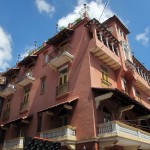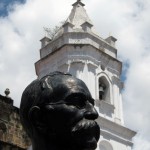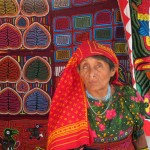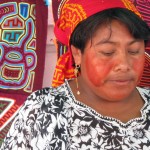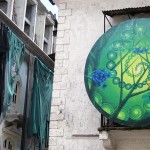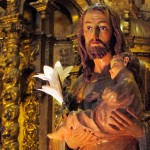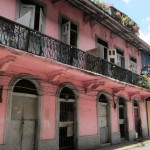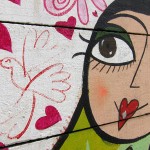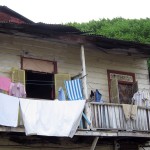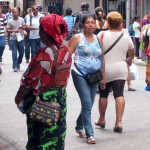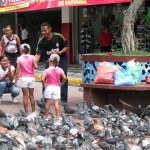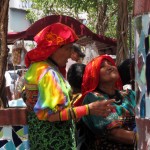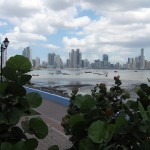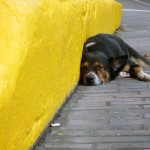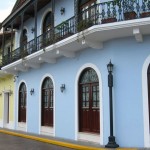Omar picks us up, ten minute cab ride to the Old Town of Panama City. The residential Presidential sits large and white on the edge of the raised town, overlooking the rapidly growing skyline, skyscrapers pushing ever taller in this financial hub. There’s the Trump Tower with its iconic sail, over there the Revolution Tower with its iconic twist, a dozen or more reach seventy stories.
An armed soldier gives us the nod, we enter the town, winding our way through the inner streets of a city that sleeps in until 11am. We walk to the town square, the Kuna women, indígena, are setting up their wares – the mola, carvings, jewelry, purses. Ali Sun is smitten with the Kuna dress – colorful, hand-woven, proudly worn by women who rarely reach five feet.
We sit in a Catholic church, the familiar iconographic art and altar are peaceful and much more grand than most of the Panamanian architecture, although the detail hardly compares to the exquisite workmanship of Italian churches. A beggar in a pew asks for change – perhaps the first one we have encountered in all of Panama.
The town starts to awaken; tour groups, fifty or more at a time, push west from the luxury coaches. The turistas are usually large, white, unmistakably American. We swim upstream, east, into the surrounding neighborhood. Laundry hangs from every balcony, a small television blares from a sparsely furnished apartment, little rooms open onto the street offering the services of a seamstress, a leather worker, a florist.
We reach a square where shoe shiners smoke cigarettes, long vines hang from old trees surrounding the shabby central gazebo. We walk north, descending slightly, the walking street surrounded by stores large and small. We didn’t think we had time for Avenida Central, we find ourselves on it. Kuna women walk together, shopkeepers sell their wares, fruit and vegetable vendors set up rickety tables on the sidewalk. A man feeds pigeons around two identically dressed girls – they delight as the birds gather and scatter and return.
We turn around and walk. Something catches my eye to the left. We squeeze into an alley that dips and winds, deep and dark. Down the middle, vendors offer the wares of a swap meet – old magazines, books, incense, whole coconuts. Corrugated metal covers the tops of the vendor stalls, blocking all but the most aggressive sunlight, the sidewalk below us irregular and broken. We are far, far away from the cold comfort of the first world, plunged into a rich marketplace of sights and smells.
On our right, an altar fills a room. Christian, indigenous, Buddhist, other religious items and symbols I don’t recognize. We stand on the edge, not entering. Three blocks we walk, emerging onto a main road near the entrance of Old Town, behind us an almost timeless alley, unfrozen from the constraints of renovation, tourism and appearances.
